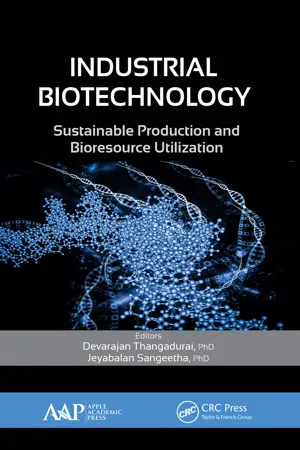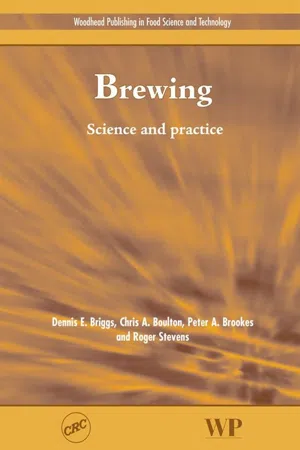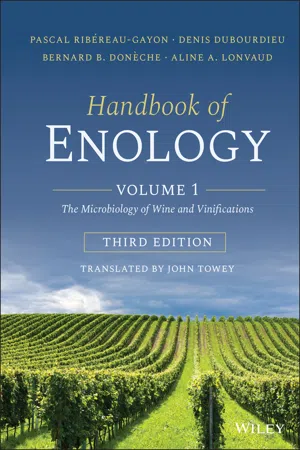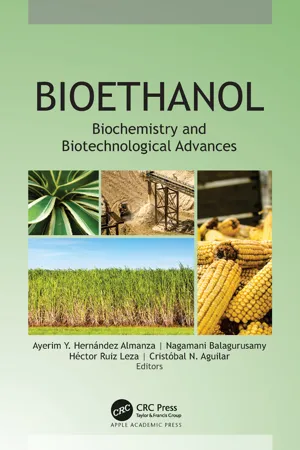Biological Sciences
Yeast
Yeast is a type of fungus commonly used in biological research and various industrial processes, including baking and brewing. It is a single-celled organism that reproduces asexually through budding. Yeast plays a crucial role in fermentation, converting sugars into alcohol and carbon dioxide, and is also used as a model organism for studying cellular processes and genetics.
Written by Perlego with AI-assistance
5 Key excerpts on "Yeast"
- eBook - ePub
Industrial Biotechnology
Sustainable Production and Bioresource Utilization
- Devarajan Thangadurai, Jeyabalan Sangeetha, Devarajan Thangadurai, Jeyabalan Sangeetha(Authors)
- 2017(Publication Date)
- Apple Academic Press(Publisher)
CHAPTER 3 INDUSTRIAL PRODUCTION AND APPLICATIONS OF Yeast AND Yeast PRODUCTS REBECCA S. THOMBRE 1 and SONALI JOSHI 2 1 Department of Biotechnology, Modern College of Arts, Science and Commerce, Pune, Maharashtra, 411005, India 2 Department of Biotechnology, Fergusson College, Shivajinagar, Pune, Maharashtra, 411004, India CONTENTS 3.1 Introduction 3.2 Classification 3.3 Physiology and Biochemistry of Yeast 3.4 Growth and Reproduction 3.5 Yeast Products 3.5.1 Alcoholic Beverages 3.5.2 Brewing Yeasts 3.5.3 Distiller’s Yeast 3.5.4 Wine Yeasts 3.5.5 Baker’s Yeast 3.5.6 Probiotic Yeasts 3.5.7 Nutritional Supplements 3.5.8 Tibicos 3.5.9 Yeast Extract 3.5.10 Sourdough Starter 3.6 Yeasts in Bioremediation 3.7 Yeasts in Medicine and Cancer Research 3.8 Yeast as a Model Organism for Genetic Studies and Recombinant DNA Technology 3.8.1 Yeast Vectors 3.8.2 Yeast Artificial Chromosomes 3.9 Conclusion Keywords References 3.1 INTRODUCTION Yeast is one of the most commonly used organisms with immense applications in food and dairy industry (Table 3.1). Yeast has been used in many ancient civilizations for the process of fermentation in the preparation of wine or bread. The ancient humans did not know that they ‘leaven’ that they were using are nothing but Yeast. Yeasts are unicellular fungi that occur in the natural environment on fruits, leaves of plants, in soil and in aquatic and environments. Lodder (1970) defined Yeasts as unicellular fungi that reproduced by budding or fission as their mode of asexual reproduction. However, this definition lacked the description of dimorphic Yeast species that produce hyphae/pseudohyphae in addition to unicellular growth (Flegel, 1977; Kendrick, 1987). 3.2 CLASSIFICATION Oberwinkler classified Yeasts as unicellular organisms belonging to either ascomycetes or basidiomycetes group of fungi (Van der Walt, 1987) - eBook - ePub
Brewing
Science and Practice
- D E Briggs, P A Brookes, R Stevens, C A Boulton(Authors)
- 2004(Publication Date)
- Woodhead Publishing(Publisher)
Rose and Harrison, 1971 ). An assistant of Hansen, Schiönning reported the occurrence of a sexual phase in the Yeast life cycle. This was confirmed in the 1930s when Øjvind Winge also working at the Carlsberg Foundation provided a full description of the Yeast haploand diplophases.As early as 1897, Büchner demonstrated the formation of ethanol and carbon dioxide from sugar using a cell-free extract of Yeast, thereby providing the foundation for the development of modern biochemistry. Yeast has been used as a convenient experimental organism in many subsequent investigations. The zymologist, A. H. Rose, proposed in the introduction to the second volume of the first edition of The Yeasts (Rose and Harrison, 1971 ) the initiation of 'Project Y'. This suggested that Yeast be used as a model eukaryotic organism in an integrated approach to the study of cell biology. This challenge has been taken up and the academic literature devoted to Yeast in general and Saccharomyces cerevisiae in particular is now immense. Many of the discoveries in cell biology, physiology, biochemistry and genetics were made using Yeast cells. Probably, S. cerevisiae is the most extensively studied cell. This has culminated in the sequencing of the entire genome of S. cerevisiae , the first species for which this has been accomplished (Goffeau et al. , 1996).11.2 Taxonomy
Taxonomy is the science of the classification of organisms. Using criteria such as morphology, life cycle, immunological properties, biochemical capabilities and genetic analysis, organisms are grouped into hierarchies of relatedness and difference. Systems of taxonomy indicate functional and evolutionary relationships between groups of organisms and they provide a framework for identifying unknown types. Taxonomy has practical importance in brewing. It allows the identification of proprietary Yeast strains and the ability to distinguish these from contaminants such as wild Yeasts. - eBook - ePub
- Sérgio Luiz Alves Júnior, Helen Treichel, Thiago Olitta Basso, Boris Ugarte Stambuk(Authors)
- 2022(Publication Date)
- Bentham Science Publishers(Publisher)
15 ]. Indeed, these microorganisms have proven to be increasingly versatile; not withstanding the countless industrial processes in which these microorganisms are already employed, it seems that they can be applied in an even greater variety of bioprocesses in the future. This chapter will summarise the main biotechnological applications of Yeasts and outline their ecological roles, which also positively impact human welfare.THE THINGS WE LOVE THE MOST
The most traditional biotechnological products, whose processing involves the use of Yeasts, are also the most profitable ones. Besides, these products are also related to the joy, happiness, sociability, and pleasure of individuals. Therefore, they are very likely the bioproducts that humans enjoy the most. Together these industrial segments of joy comprise a trillionaire market, surpassing US$ 1.3 trillion worth of value.Alcoholic Beverages
Most alcoholic beverages are produced due to the fermentation capacity of Yeast cells. In this scenario, the species S. cerevisiae stands out as the primary Yeast used for the beverages with the highest production volume and the most extensive market sizes (Table).1Table 1 Alcoholic beverages and their markets.Dominant Yeast Species in the Processes Beverage Global Productiona Global Market Size References/Sources S. cerevisiae and S. pastorianus Beer 194 billion L US$ 623 billion [17 , 19 ] S. cerevisiae Wine 29.2 billion L US$ 327 billion [17 , 18 , 20 ] S. cerevisiae Whiskey 5.2 billion L US$ 60 billion [21 - 23 ] S. cerevisiae Vodka 3 billion L US$ 45 billion [24 - 26 ] S. cerevisiae Tequila 0.25 billion L US$ 10 billion [27 - 29 ] S. cerevisiae Sake 0.6 billion L US$ 9 billion [30 - 32 ] S. cerevisiae Cachaça 1.8 billion L US$ 2 billion [33 , 34 ] a Approximated values per year.Beer is a non-distilled beverage obtained from the fermentation of a wort composed of malted cereals, hops, and freshwater. Besides its millenary history, beer is now the leading alcoholic product consumed in the world. Its production has increased gradually over the last decades [16 ], reaching 194 billion liters in 2018. This amount represented a 50% increase in the last two decades and was six times higher than the wine production in that same year (29.2 billion liters) [17 - eBook - ePub
Handbook of Enology, Volume 1
The Microbiology of Wine and Vinifications
- Pascal Ribéreau-Gayon, Denis Dubourdieu, Bernard B. Donèche, Aline A. Lonvaud, John Towey(Authors)
- 2021(Publication Date)
- Wiley(Publisher)
CHAPTER 1 Yeasts- 1.1 Introduction
- 1.2 The Cell Wall
- 1.3 The Plasma Membrane
- 1.4 The Cytoplasm and Its Organelles
- 1.5 The Nucleus
- 1.6 Reproduction and the Yeast Biological Cycle
- 1.7 The Killer Phenomenon
- 1.8 Classification of Yeast Species
- 1.9 Identification of WineYeast Strains
- 1.10 Ecology of Grape and Wine Yeasts
1.1 Introduction
Man has been making bread and fermented beverages since the beginning of recordedhistory. Yet the role of Yeasts in alcoholic fermentation, particularly in the transformation of grapes into wine, was only clearly established in the middle of the 19th century. The ancients explained the boiling during fermentation (from the Latin fervere, to boil) as a reaction between substances that come into contact with each other during crushing to produce effervescence. In 1680, a Dutch cloth merchant, Antonie van Leeuwenhoek, first observed Yeasts in beer wort using a microscope that he designed and produced. He did not, however, establish a relationship between these corpuscles and alcoholic fermentation. It was not until the end of the 18th century that Antoine Lavoisier began the chemical study of alcoholic fermentation. Joseph Louis Gay‐Lussac continued Lavoisier's research into the next century. As early as 1785, Adam Fabroni, an Italian scientist, was the first to provide an interpretation of the chemical composition of the ferment responsible for alcoholic fermentation, which he described as a plant–animal substance. According to Fabroni, this material, comparable to the gluten in flour, was located in special utricles, particularly on grapes and wheat, and alcoholic fermentation occurred when it came into contact with sugar in the must. In 1837, a French physicist named Charles Cagnard de La Tour proved for the first time that Yeast was a living organism. According to his findings, it was capable of multiplying and belonged to the plant kingdom; its vital activities were the basis for the fermentation of sugar‐containing liquids. The German naturalist Theodor Schwann confirmed his theory and demonstrated that heat and certain chemical products were capable of stopping alcoholic fermentation. He named the beer Yeast zuckerpilz, which means sugar fungus—Saccharomyces - eBook - ePub
Bioethanol
Biochemistry and Biotechnological Advances
- Ayerim Y. Hernández Almanza, Nagamani Balagurusamy, Héctor Ruiz Leza, Cristóbal N. Aguilar(Authors)
- 2022(Publication Date)
- Apple Academic Press(Publisher)
Finally, it is important to reaffirm the ability of Yeast cells to grow, metabolize complex industrial raw materials and withstand the hostile environments of large-scale fermenters. Throughout this chapter, important considerations of Yeast stress and nutritional physiology that influence Yeast fermenta-tive activities have been addressed. In addition to the Yeast optimization and improvement strategies used in alcohol production, it is a priority to know the Yeast strain to use in order to carry out the correct approach when carrying out the fermentation process. Even today, Yeasts continue to be one of the least understood organisms, and in the same way they are among the most important as input in ethanol production processes. Even so, under the correct conditions of both feeding and environment, it is currently possible to obtain volumes of more than 20% of ethanol production, when these conditions are not met, leading to stress in the lead, stuck, slow, and inefficient fermentations are obtained. Therefore, it is essential to optimize alcoholic fermentations to understand aspects of Yeast cell physiology, particularly when lignocellulosic substrates are used for the production of second-generation bioethanol.KEYWORDS
- alcohol dehydrogenase
- bioethanol production
- biorefinery
- growth conditions
- lignocellulosic biomass
- Yeast physiology
REFERENCES
- Dzialo, M. C., Park, R., Steensels, J., Lievens, B., & Verstrepen, K. J. , (2017). Physiology, ecology, and industrial applications of aroma formation in Yeast. FEMS Microbiol. Rev. , 41, S95–S128. https://doi.org/10.1093/femsre/fux031 .
- Buzzini, P., (2006). Yeast biodiversity and biotechnology. Yeast Handbook; Biodivers. Ecophysiol. Yeasts , pp. 533–559. https://doi.org/10.1007/3–540–30985–3_22 .
- Van, D. S. P. , (2015). Approaches to production of natural flavors. In: Parker, J. K., Elmore, J. S., & Methven, L. B., (eds.), Flavor Development, Analysis and Perception in Food and Beverages (pp. 235–248). Woodhead Publishing. https://doi.org/https://doi.org/10.1016/B978–1–78242–103–0.00011–4 .
- Araújo, W. A. , (2016). Ethanol industry: Surpassing uncertainties and looking forward. In: Global Bioethanol.
Index pages curate the most relevant extracts from our library of academic textbooks. They’ve been created using an in-house natural language model (NLM), each adding context and meaning to key research topics.
Explore more topic indexes
Explore more topic indexes
1 of 6
Explore more topic indexes
1 of 4




